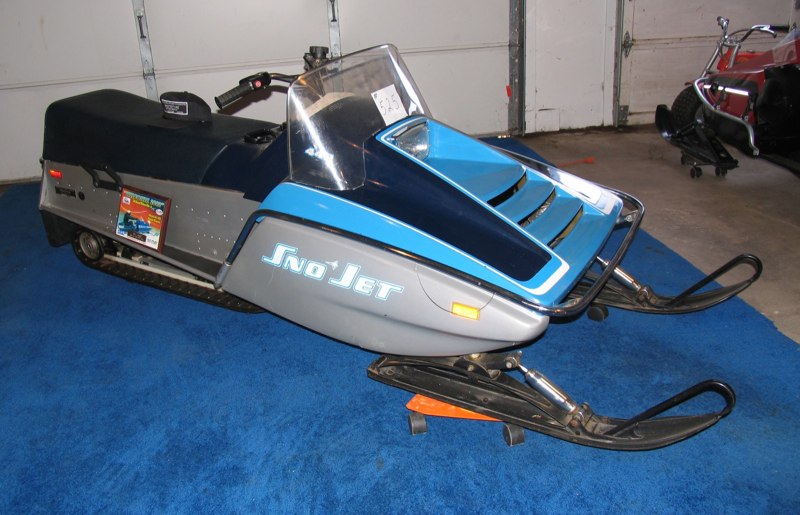
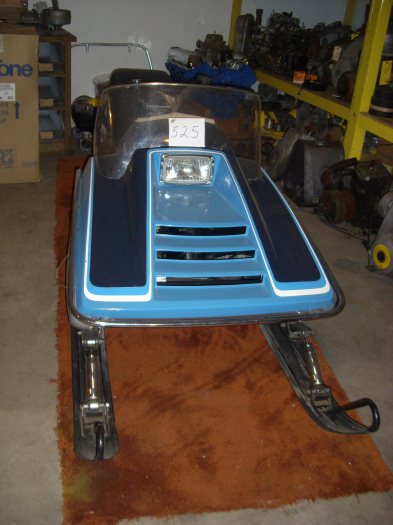

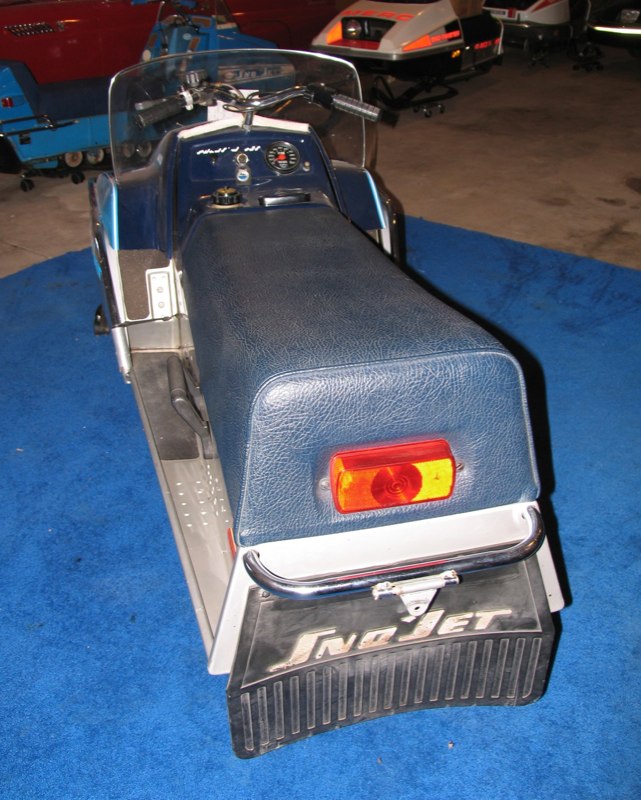
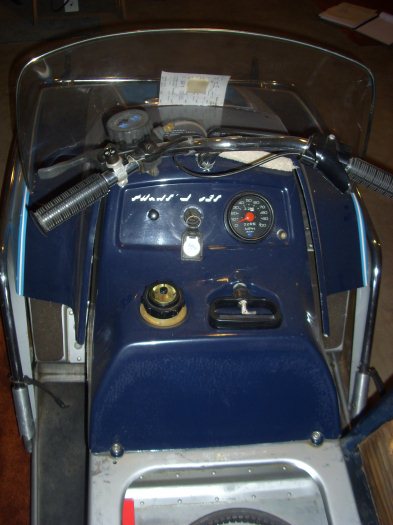
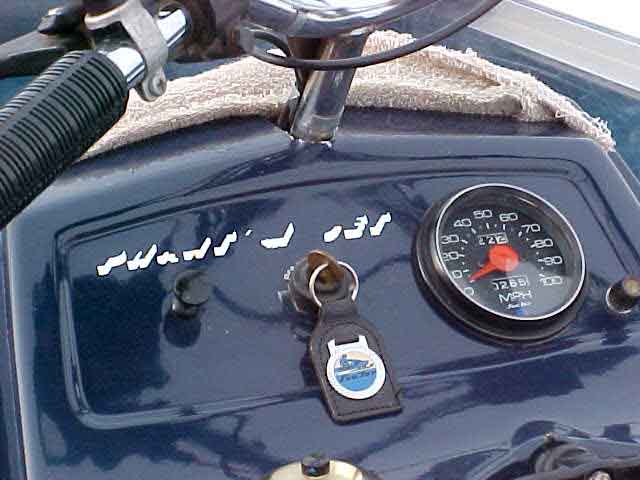
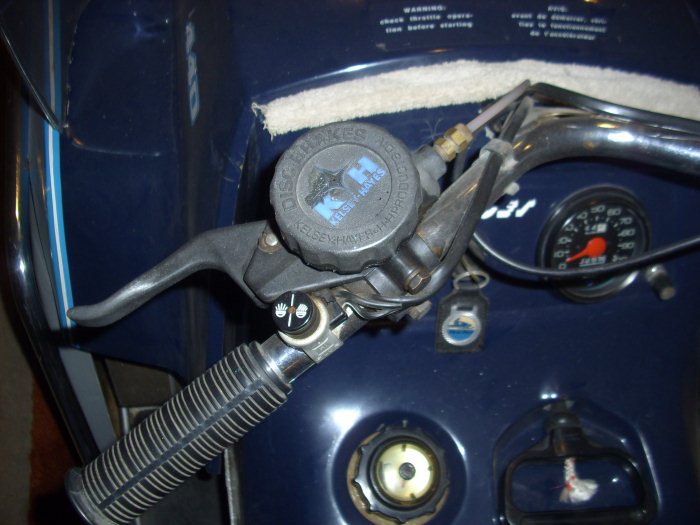
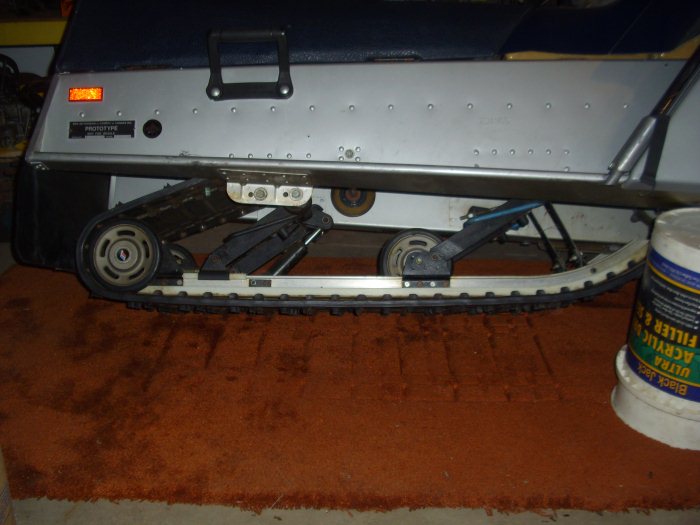
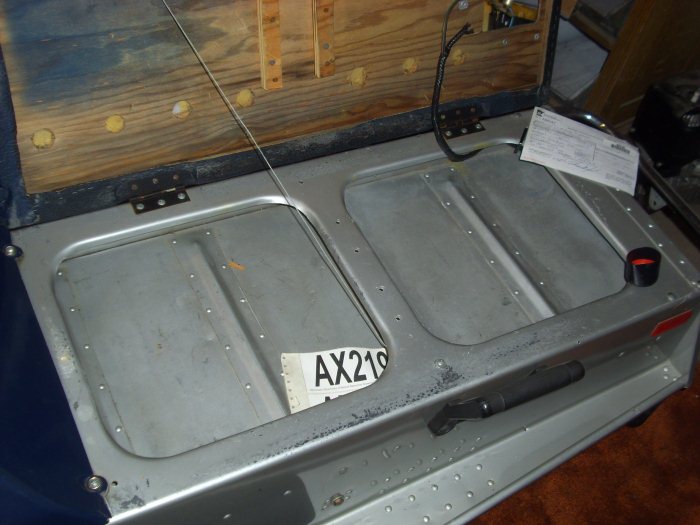
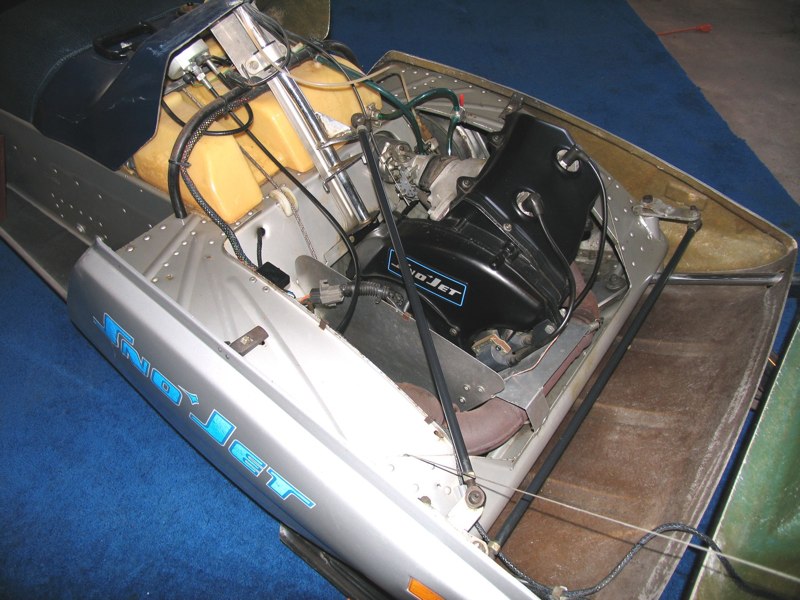
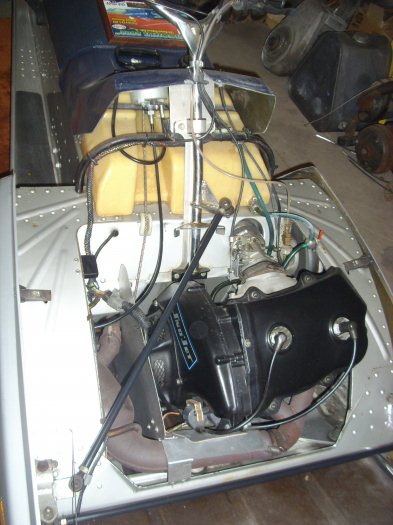
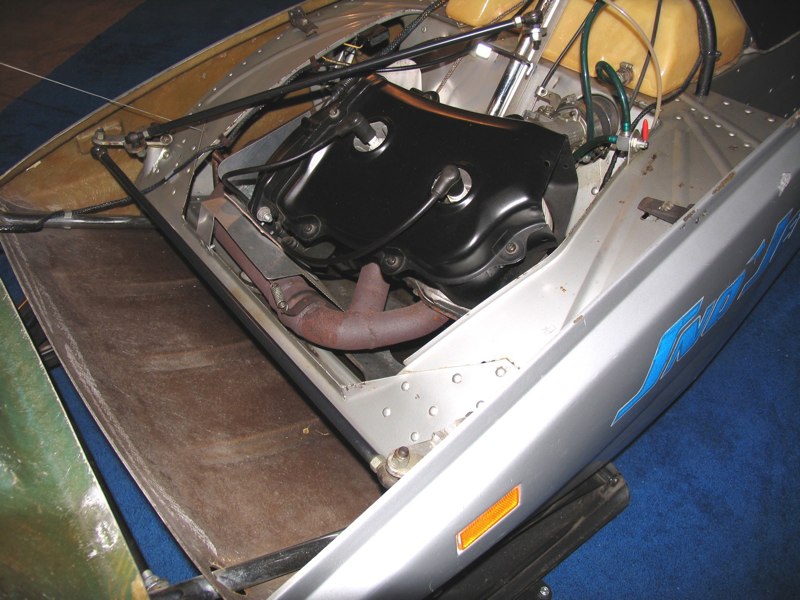
This article came about as a result of doing research on a vintage Sno Jet prototype that I acquired. In doing this research I have communicate with several former Sno Jet personal and associates, they all were very helpful. I am sincerely thankful and appreciative of the time and information everyone contributed. Most did not want their name on the web or in print media, two individuals willing to have their names mentioned were Peter Morris and Gordon VanAmburg. Nearly all of the communication was verbal with the exception of Peter Morris. Almost without exception, each individual stated that, it has been 30-40 years and the information is to the best of their memories. The best way for me to organize it was to combine the information into a series of articles. The research migrated into several Sno Jet related topics, making it impossible to include it all in one. Virtually all of my communication with Peter Morris was written, which made it nice to refer to over the notes I made from others and handy to select some applicable quotes. Thanks Pete for your additional time spent typing and your willingness to be quoted. The information gained from all is intertwined into the content throughout. I have written additional articles on the topics of; Sno Jets Last Prototype, Presidents Council and Presidential FA’s and Targeted History Timeline Sno Jet. Some overlap exists to allow the articles to stand-alone.
*Notates a quote
* “April 1974 “Sno Jet has also completed and built a number of 1976 machines. These sleds are completely new and employ several revolutionary engineering techniques in their design and assembly. They are currently undergoing testing and evaluation at the factory level. Current plans call for an early release program through the Presidents Council. Thus both 1975 and 1976 will see the introduction of completely brand new snowmobiles from Sno Jet.” Sno Jet Spokesperson, Snow Goer Trade 5/74
What were these “revolutionary sleds” planned to occupy showrooms for 1976? I promise we will explore them along with their story. First I want to take a brief moment and provide a general overview and some insights into Sno Jet’s prototypes.
Prototypes
You could separate Sno Jet’s prototypes into three categories.
The first category would consist of early versions or stages of what may ultimately become a production sled. These sleds had nearly all hand made one off components, systems that may not actually function yet and may have lacked certain appearance features. The purpose was to start with the basic foundation design and concepts and then build on them once tested and working properly.
The second category would be more advanced versions of the first, these would be sleds that had been developed to the point of production. These usually were the final hand builds, may have a number of production parts on them and were extensively tested just prior to the production line being fired up.
The third category would be prototypes built using many existing model components with the intention of making moderate to extensive changes to the model. This category historically had the fewest prototypes built, as changes between model years were usually minimal and Sno Jet would just use a production built unit to test and make minimal refinements.
Regardless of which type of prototype Sno Jet produced, they all had the same destiny. Sno Jet had a very strict policy and that was, prototypes of every form were to be destroyed when their purpose had been completed. Even the company employees were not allowed to acquire the prototypes, the only exception was that some parts were maintained at times for future use within the departments.
* “Considering the prototypes were just intended to be test beds, and never to end up in the hands of the public... I believe that since there were strict legal conditions on what a prototype could be… it was likely that when it’s time as a test bed was done, you could save it for a life in a museum setting, or scavenge parts to go back in the shop for internal use, or just (sadly) send it to the crusher. But, never under any circumstances should it be sold as a production sled--- new, or used. Thus the badge, to prevent that.” Peter Morris
The first beginnings of a new sled started with design and concept.
* “Once you have reviewed a number of sketch proposals for the styling on cowls, instrument panels, etc, those sketches become a very reduced number of more refined renderings. Once these have been reduced to one finalist, actual volumes are drawn up in full scale to establish volumes, motor clearances and such. I was mostly involved in these stages. Even the full-scale layouts, were expected to be tweaked later, if needed, as visual and mechanical details would usually need to be refined further. These layouts were then turned over to the model makers. They would build a solid platform, with a X-Y grid on its floor to start creating a full-sized clay form. Once stylists and modelers were happy with the 'final' shape, they poured a special 'Hydro Stone plaster over the clay to get a rigid female mold. Once the plaster mold was polished, you could lay up fiberglass into the female mold, and pull out several male copies.” Peter Morris
The team would set about to literally fabricate and build what was until this point mainly on paper. Once built, much of what I would consider to be fun, could really start. They would test year around, out the factory door, traveling anywhere they could find snow and on the grass when no snow was available.
* “We had plenty of open space nearby to go play and test on company time (as well as borrowing them on the weekends and evenings). During the winter, this could be done right out of the shop door. When we were scarce on snow in the Spring and Fall, we would pop one or two into the back of a pickup, and go find snow on some of the mountain passes that were closed in the winter. So, if you happened to be hiking up Smuggler’s Notch, or Lincoln Gap, on snowshoes in late May (or early November) you might see a bare-chassis Phantom, or next year’s T-Jet screaming past you, in a blur. We even mounted some bottles with hoses (filled with water and dishwashing detergent) to feed the slider suspensions to keep them (somewhat) lubed, in the high grass, in the summer! Those still fried pretty quickly, but when you’re desperate for test results…” Peter Morris
* “Sno-Jet had created a program where anyone in the company could borrow a new Ski-Doo, Polaris, or whatever, to take home for the weekend. Also, any new Sno-Jet models, plus some of the Sno-Jet prototypes that may be 2 or 3 years away from production. We, in the R&D teams, got first dibs on the protos of course. The only condition to borrowing any sled was that you had to fill out a review sheet, after you returned the sled. What did you like about it, what did you hate, and the like. These reviews were turned over to marketing to assess where we were vs. the competition.” Peter Morris
* “We had become major curiosities in our neighborhood, as we often came home with prototype sleds that were often 3 or more years away from production. We might bring home an SST proto or two, yours in fact, and friends would gather to check out the sleds. "Wow... what the hell is that?... A Sno-Jet... I checked out the showroom last week, and never saw one like that... Well, this one is a 1976 model...” Peter Morris
The prototypes saw severe duty, they were not pampered. The parts and systems were changed and tested very frequently as they evolved to what would hopefully become a production sled.
* “The prototypes were never meant to be treated with kid gloves. Although rare and unique, their assigned duty was to pin-point any fragility or glitches in assessing how the initial design would fare as a production sled. Sno-Jet did not discourage anyone from treating them roughly. If fractures appeared when you beat them up on jumps, and getting air, they wanted to know where those might happen so they could consider a redesign before sending final blueprints to manufacturing. If there were overheating problems, the engineers and mechanics would get out sabre saws and duct tape… If people complained about sore butts on the trail, we'd discuss a different foam formulation. If no one liked where the handlebars sat (and that would include feedback from 4'-9" ladies-to-6'-6 men), we'd try several different handle bar designs and positions. Etc, Etc.!” Peter Morris
* “On protos, you often try out different accents to judge which design lives. And just as often, you might find different details on the right side of your sled than the left side, on a proto… So each was a test platform to experiment and play with… And the production may have ended up with different details than anything ever applied to the prototypes.” Peter Morris
* “That would certainly depend on what week (or even day of the week) during its evolution! Those poor rascals had likely seen every spring and shock combination, several track and slide suspension we had considered, different heights of windshields, whacked up cowls, different decals on the port side from the starboard... and probably nearly everything on the proto sled, looking for the best and most reliable (within budgetary boundaries) set ups for the final production models. So, on the day the protos were officially retired, that version may have been the closest to production specs... but not necessarily!” Peter Morris
As of this writing, there are only 3 maybe 4 prototypes that Sno Jet built known to be in existence. Two confirmed Phantom Jets, the feature character in this article and a third Phantom Jet that seems to elude any investigation and may be confused with one of the other two as ownership has changed fairly frequently since they have been known to exist. The Phantoms would fall into the second prototype category; they had some production parts, which included, suspension, track, engine and many small parts but predominantly were completely new. The other existing prototype is the 1976 SST fan, which brought about all this research.
The track and trail to the Phantom
* “Glastron decided to invest in developing a line of sleds that would give the big boys a run for their money. In searching for top-quality engineers and stylists... no one seemed too delighted with the fact they'd have to move to the asbestos capital of the universe, in a location that spoke French… remote from any life forms. This prompted Glastron to set up an R&D facility in a place where talent would love to migrate. But, not so distant from the factory that all liaison would be impossible. Essex, Vt was chosen. So, Duane, Bob, and Harlan (and then me) were brought in to start on a machine that would open eyes, and put Sno-Jet on the map. Stage I of that assault was to create a racer that would blow the rest out of the water.” Peter Morris
The assault weapon was of course the Thunder Jet. Its success and place in history is truly legendary but its purpose here is merely to help set the stage. The success realized by the T-Jet and a number of happenings in the snowmobile industry were cause for Conroy and Sno Jet to do some strategic planning. At a time when things weren’t really going that well in the industry and manufacturers were dropping out, Sno Jet implemented an aggressive growth plan consisting of a; three phase 3.5 million expansion of its manufacturing and parts capabilities and plans for a two phase new model release. The first phase of the new model release was the all-new SST, the second phase promised to be revolutionary and was planned for the 1976 model year. Sno Jets plans were BIG, they had their sites set on the likes of Bombardier, Polaris and Cat. They believed that in order for them to be sustainable long term, they had to become one of the manufacturers at the top of the heap and they honestly felt they could do it.
* “At that time, Sno-Jet R&D was a 3 man operation, working out of an old cavalry stable on a defunct Army base. One Chief Engineer: Duane Aho (now passed away), a Mechanical Design Engineer: Bob Mackin, and a Prototype Mechanic: Harland Lipker. I was the 4th member of the team.” Peter Morris
* “Glastron finally got talented engineers and stylists to come calling when the R&D facility was moved to Vermont. Our facility expanded rapidly.” Peter Morris
* “If we were going to catch up, and pass, Ski-Doo we'd need even more engineers and stylists. As related earlier, the gas crisis, and a couple of seasons with sparse snow on the ground... forced Glastron to ponder what might become of Sno-Jet, and indeed the entire snowmobile industry. They reasoned that if these were temporary issues... they should be in a position to take a commanding lead in the industry, by offering the most desirable sleds when the market recovered. On the other hand, if these conditions were seen as writing on the wall for a doomed and collapsing industry... they should also be in a strong position in considering an exit strategy. If Sno-Jet became a major player, and had some very advanced machines in the on-deck circle for future model offerings... they would have a company of value to sell. They decided not to just pull the plug, and let the company die of it's own weight, like many companies.” Peter Morris
The emphasis here and in my article on the presidential sleds, centers on this two-phase model release. Sno Jet fully intended this, one… two… punch in 1975 and 1976 to catapult them to a lead position in the industry.
* “They quickly realized that you needed to NOT design next year's sled, as next year's sled. You had to make huge leaps... design a sled as though you were going to introduce it 7 years from now... and then introduce it next year. …as you needed to design in quantum steps if you didn't want to get left in the dust, in the showroom next year. These were expected to accomplish that and more, for Sno-Jet.” Peter Morris
* “Bob had been puttering on this new design, and ran it past Duane Aho. I think I remember there being a bit of initial resistance from Duane. But Bob felt strongly enough about the potential of the design, that his persistence prevailed. There were a lot of very original concepts wrapped up in that one design. Check out the chambers below the seat, etc. I had pretty much forgotten that there was a new front suspension as a part of the overall design (until reminded on the website). So, this design was committed to leap-frogging anything on the competition's drawing board. Somewhere along in the testing period, the sled would likely, itself, announce which direction it might take in 'real life'. …the bullet-nosed, monocoque chassis was Bob Mackin's brain-child. I took Bob's layout and converted those to blueprints.” Peter Morris
* “I noticed that the sketch at the bottom of Blake's 'T-Jet II' page was actually my drawing that was the finalist design proposal! This was selected from a ton of my preliminary doodles we had reviewed.” Peter Morris
Monocoque is a construction technique that supports structural load by using an object's external skin, as opposed to using an internal frame or truss that is then covered with a non-load-bearing skin or coachwork. The term is also used to indicate a form of vehicle construction in which the body and chassis form a single unit.
So It! the monocoque chassis, Thunder II, Phantom Jet, Punch Two, the next major step in getting a foot up on the competition was born. It was not without its own internal conflicts and politics though.
* “There were likely some people in the company who initially saw this revolutionary chassis as a race sled. Others might have envisioned it as purely a production model. And some probably considered it to be introduced as a racer at first, while developing a production model... should it make a name for itself at the track. So, I'm fairly confident the mindset originally was to let this design prove it's worth... and then worry about how it was to be presented to the public, later.” Peter Morris
* “I don't think you can actually separate the Thunder Jet II, and the Phantom Jet. They are actually one in the same. You can see from my styling proposal, that Bob felt strongly that we should leave as much of the bullet-nose sheet metal exposed as possible. I had mocked up a solid foam plug of that shape, which got sent up to the factory in Quebec to have an FRP cowl made. There should be some pix out there of that design, sporting a FRP cowl. Although, Bob wanted the chassis exposed... upper management did not agree with the 'minimalist' cowl. He got out-voted on that detail. Bill Wayland come onboard... he did the fresh styling that would then be called the Phantom Jet.” Peter Morris
* “This design got a ton of accelerated test time. This is definitely one sled that mowed summer hay, with baby bottles feeding diluted dishwashing liquid to the poor Teflon/Delrin sliders! And saw testing on high mountain passes nearby, to extend the snow-testing season from early November-to-mid May.” Peter Morris
* “On the motor options... a few fan-cooled engines being tested, in varying displacements… some liquid-cooled engines under consideration. As I remember on the Phantom Jet, we were playing with using an aluminum hollow front bumper to act as the radiator on the water cooled model… playing with a bunch of ways to expose a radiator to the breeze… I don't remember any cowl design that may have accommodated a free air.” Peter Morris
* “Sno Jet has invested 1.2 million dollars in engineering and tooling for a completely new line of snow machines for 1975 to be complimented by a revolutionary new machine already built and in testing for 1976!” Keith Orme Snow Sports dealer news 5/74
As stated this development was moving swiftly, maybe to swiftly in hindsight. It wasn’t long before they had the ability to produce a final prototype product, the final stage prior to actual production. A few years prior Sno Jet had formed what they called the Presidents Council; this council included Sno Jet executives as well as distributor and dealer associates. The Council experimented with, new to Sno Jet, marketing initiatives as part of their expansion plans, these initiatives included testing ways to release new models. Both the all-new SST’s and the Phantom’s had unique but different early release programs designed for them. One of the differences with the Phantom’s program was that; for the first time in Sno Jets history, actual prototypes rather than production models were loaned to associates outside of the company. The program required that written feedback and data along with the sled were to be provided back and returned to Sno Jet. In January 1974 Sno Jet produced, memory recalls, less than 10, but a larger than normal number of Phantom Jet prototypes for this program. It is unknown whether all of them were loaned under the program and how many of them were returned. We know from history that at least two were not returned, as they exist today in collector’s hands escaping their grizzly fate. The units that did get returned or were never loaned out, are assumed to have been destroyed, as Sno Jets policy would dictate.
* “I doubt there were ever more than 3 completed, even back then. There were likely enough spare parts ordered to knock a few more out, but probably never happened. Harland may be the only remaining one from the Vermont team that would have a trustable answer to that question.” Peter Morris
At this time the plans for the 1976 models were fairly complete but subject to change as usual. These plans included in no specific order:
The trail we’ve been on getting here was a fast exciting scenic one seeming to hold a future full of adventurous riding only to suddenly end at the edge of a cliff with no available detour…. Sadly the Phantom was experiencing frequent and consistent structural failures in the field, which at the very least would have delayed its use in production models. The industry too was spiraling downward rapidly at the same time literally dragging many of the manufacturers hitched to it on a reckless ride into the dusty history books.
* “…the determination had been made that the chassis was not up to the task, durability-wise. So the Phantom was mothballed. The fate of the entire company was totally up in the air at that time. If the market came back strongly, I think there was a door left ajar to go back and see if it could be revived as a production model. If things continued as they were threatening to, no one wanted to be responsible for throwing money down a hole. So, that model would have been left in limbo, as it and the whole company were tied to the same fate.” Peter Morris
* “I remember discussing race sled design with Duane over lunch one day, early on. I was of the impression a race sled would be heavier-duty than a production model, as it was subjected to much more of a beating. He corrected me. He said that you need to make it as light as possible, and as powerful as possible, to race. These two forces, it seemed to me, would be double-teaming to make a sled break. He continued... anybody with a production sled expects it to last forever, and does not want to have it spend any time back in the shop for repair. On the other hand, on a racing sled... if you can provide a winning formula to bring home a trophy on Saturday... the driver and mechanic do not mind patching and repairing that sled on Sunday. So, the race sled is much more light-duty! I found that pretty eye-opening. So, perhaps this suggests that the monocoque chassis would have done just fine as a pure race sled. Projecting beyond that, had it been given one more chance at chassis upgrades and refinements... it might have made a fine production sled too.” Peter Morris
The following Photos of a surviving Phantom Jet are provided with the permission of its current owner Ed Webb. Ed also owns a “president’s council” SST.











